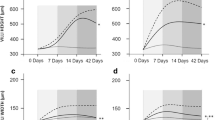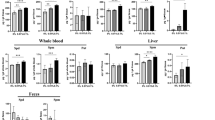Abstract
It has been recently reported that valine, which was one of the branched chain amino acids, enhanced liver regeneration after a hepatectomy in rats. The aim of this study is to investigate the effect of enteral valine supplementation on the intestinal adaptation of short bowel syndrome using a rat model. Seven-week-old male Lewis rats underwent a 90% small bowel resection. The rats were randomly divided into two groups; Group V (valine-rich diet which contains valine, five times as the normal amount of valine as that found in standard rat chow) and Group S (standard rat chow), according to the diet each group received. The rats were killed and evaluated at the operative day, and postoperative days (POD) 7, 14, 30, and 60, respectively. The parameters of estimation were body weight (BW), a blood amino acids analysis, a urine organic acids analysis and a morphological examination of the residual small intestines. The BW and the intestinal wet weight, jejunal crypt depth and proliferating cell nuclear antigen positive cells in Group V at POD 7 were significantly higher than in Group S, while those in the Group V at POD 30 and 60 were smaller than in Group S. The urine methylmalonic acid (MMA) level in Group V at POD 30 and 60 was much higher than in Group S. The valine-rich diet was thus found to enhance intestinal regeneration after a small bowel resection in the acute phase. However, the long-term valine-rich diet supplementation was found to disturb the intestinal adaptation, which might be caused by the high production of MMA due to the valine-rich diet. This is the first report in which valine was used as a promoter of intestinal adaptation.











Similar content being viewed by others
References
Rickham PP (1967) Massive small intestinal resection in newborn infants. Ann R Coll Surg Eng 41:480–492
Kurkchubasche AG, Smith SD, Rowe MI (1992) Catheter sepsis in short bowel syndrome. Arch Surg 127:21–25
Lowrence JP, Dunn SP, Billmire DF, et al (1994) Isolated liver transplantation for liver failure in patients with short bowel syndrome. J Pediatr Surg 29:751–753
Grant DR (2003) Intestinal transplant registry. presented at VIII In: International small bowel transplantation sympodium, Miami, FL, 10–13 September 2003
Serrano MS, Schmidt-Sommerfeld E (2002) Nutritional support of infants with short bowel syndrome. Nutrition 18:966–970
Hebiguchi, et al (1997) The Effect of arginine supplementation on growth hormone release and intestinal mucosal growth after massive small bowel resection in growing rats. J Pediatr Surg 32:1149–1153
Weiming Z, Ning L, Jieshou L (2004) Effect of recombinant human growth hormone and enteral nutrition on short bowel. J Parenter Enteral Nutr 28:377–381
Sukhotnik I, Mogilner J, Shamir R, et al (2005) Effect of subcutaneous insulin on intestinal adaptation in a rat model of short bowel syndrome. Pediatr Surg Int 21:132–137
Ogita K, Suita S, Taguchi T, et al (2002) Roles of nucleosides and nucleotide mixture in small bowel. Nutrition 18:338–342
Freund HR, James JH and Fischer JE (1981) Nitrogen-sparing mechanisms of singly administered branched-chain amino acids in the injured rat. Surgery 90:237–243
Chida A, Doi H, Komatsu H, et al (2003) The effect of valine on lipid metabolic homeostasis in regenerating remnant liver after hepatectomy.J Surg Met Nutr 37:179–188
Murakami K, Doi H, Takahashi T, et al (2004) Effect of L-valine-supplemented total parenteral nutrition on the rat intestinal mucosa after 5-fluorouracil-induced. J Surg Met Nutr 38:47–59
Fulks RM, Li JB, Goldberg AL (1981) Effects of insulin, glucose and amino acids on protein turnover in rat diaphragm. J Biol Chem 250:280–298
Odessey R, Khairallah EA, Goldberg AL (1974) Origin and possible significance of alanine production by skeletal muscle. J Biol Chem 249:7623–7629
Murray RK, Granner DK, Mayes PA et al (eds) (2000) Harper’s Biochemistry, 25th edn. Appleton & Lange, New York
Fenton WA, Gravel RA, Rosenblatt DS (2001) Disorders of propionate and methylmalonate metabolism. In: Scriver CR et al (eds) The metabolic and molecular basis of inherited diseases, 8th edn. McGraw Hill, New York, pp 2165–2193
Acknowledgements
This work was supported in part by Grant-in-Aid for Scientific Research from the Japanese Society for the Promotion of Science. The authors also thank Mr. Brian Quinn for reading the manuscript.
Author information
Authors and Affiliations
Corresponding author
Rights and permissions
About this article
Cite this article
Takada, N., Ogita, K., Taguchi, T. et al. Effect of a valine-rich diet on a rat model of short bowel syndrome. Ped Surgery Int 21, 899–906 (2005). https://doi.org/10.1007/s00383-005-1508-4
Published:
Issue Date:
DOI: https://doi.org/10.1007/s00383-005-1508-4




